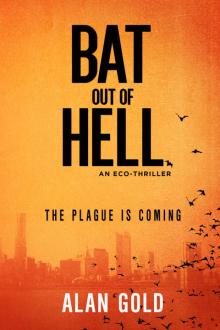Bat out of Hell Read online
Page 2
“Bats could be the vector,” she said, “but I’ve had epidemiologists working on samples since we returned from Indonesia, and it could just as easily have been monkeys, spiders, ticks, mosquitoes, or anything. We certainly haven’t ruled out bats, but it’s less likely to be them than it is an insect infecting a larger animal. The infection could have entered the human body through sores, the air, food . . . we just don’t have enough information,” she said.
“I’m telling you, it’s bats. I’ve been waiting for this for years, and all the stars are aligned. Today it’s the jungles of Indonesia; tomorrow, and I mean tomorrow, it’s going to be the jungles of New York and Washington.”
She looked at him in astonishment.
ORLANDO, FLORIDA
Megan was a woman with four grandchildren by two of her three kids, a deacon in her local church, president of her local branch of the Democratic Party, and she’d once been asked to stand for city council. She looked around at the other women grouped on a busy street in the humid morning, the air still, the road heavy with traffic. There were twenty of them. They had gathered in silence outside Goldstein’s Fur Shop.
Abe Goldstein had been watching them assemble on the other side of the road for the past twenty minutes before crossing over to block his entrance and window display. He feared that something was up. He’d gone outside his shop to inquire if he could help the ladies, but those that had arrived early had merely given him the cold shoulder, treating him like some pork butcher at a bar mitzvah. Now he knew from the experience of other fur traders in Miami, New York, and Washington what to expect.
On the one hand, the publicity was good—it brought attention to his shop, which could lead to sales—but on the other, bad publicity could damage his retirement plans. The fur trade had been farshtunken for years, and he was hoping to sell his shop to some schmuck who didn’t know the future of furs was in real tsuris, go live in Miami with Zelda, and spend the kid’s inheritance living like the people to whom he occasionally sold the odd ermine or sable. He couldn’t remember the last time he’d sold a full-length coat, even to the wealthy Jewish retirees who spent the remains of their lives playing canasta and mah-jongg and looking to wed a replacement for Morrie or Saul or Ike who’d died at sixty-three of a heart attack when they lived in New York.
Abe eyed the women with trepidation. He’d already called the police, and although the captain owed him a favor for the discount he’d given him for the fur wrap he’d bought his girlfriend, the captain said that they’d be there the moment there was trouble.
Megan eyed Abe through the shop window. She’d seen him use the phone, presumably to call the police. She just hoped they didn’t get here before the newspaper reporters and television people. She looked at her watch and wondered where Daphne and Chloe were. Everybody else was here. Women aged in their late teens, mothers in their twenties and forties, and grannies like her. Women assembled outside a shop that traded on the misery of harmless animals. Fur skinned in the cruelest of manners—animals trapped by the leg, some even chewing off their feet to escape the cruel teeth of the snares. The signs and banners were safely tucked away in Sally’s SUV, waiting to be hauled out when the media turned up.
As so often the case, the media arrived in a convoy—two television station vans with satellite dishes eclipsing their roofs, three radio station vans emblazoned with their identification badges announcing garishly who they were, and then a couple of anonymous station wagons, presumably belonging to newspaper reporters and photographers. Megan smiled, knowing that her embargoed press release had worked beautifully. Right time, right place, and certainly the right headline on the press release: CHAT Women to bare their breasts for bears, foxes, and other endangered animals.
Megan marched over to the SUV and threw open the doors. She withdrew the signs and banners and handed them to the girls. Then she said loudly so that the media would hear, “Okay girls, bare it for the bears . . .”
At the signal, the women walked in front of the fur shop, put down the signs they were carrying, and in a fluid movement, stripped off their blouses, jumpers, and bras. Men and women passing stopped and looked in shock at the sudden expanse of naked flesh. Some of the men began to whistle and applaud; others, especially the women, frowned and tutted in disgust.
But Megan didn’t care. Naked from the waist up, she bent down and picked up a sign that read SKIN THE TRADERS, NOT THE ANIMALS. Some of her other colleagues carried their signs and they formed a circle in front of the fur shop that they marched around, chanting their mantra, “CHAT to us . . . say no to fur.”
The cameras flashed, the sound recordists set up their recorders, and the television cameras jostled with the crowd to get the best shots and angles.
All would have gone peacefully, had not Bob Gentle, Jill’s husband, been carried away. Jill was one of the younger women marching in the circle, awaiting the arrival of the police and some manhandling of her naked torso, which she hoped would get onto the network news. But Bob, recently indoctrinated by Jill in the cruelty of the fur trade, found himself unable to control his emotions, and without fully realizing what he was doing, he picked up a car jack and hurled it through the window of Abe Goldstein’s fur shop. A hush came over the crowd as the glass shattered, and large broken panes came crashing onto the pavement. The good nature of the demonstration evaporated at that instance. Abe came running out of the shop, shouting and gesticulating. The women stopped marching and looked in dismay at the broken window and the thousands of shards of glass on the floor.
Realizing how stupid he’d just been, Bob walked over to apologize to Abe; but as he stepped forward, out of the corner of his eye, he saw a blurred figure, wearing a parka with a hood pulled up to hide his face, suddenly appear from the back of the crowd. The figure, medium height and looking like some neighborhood punk, walked quickly to the broken window, crunching over the shards of glass on the pavement.
Having been robbed four times in ten years, Abe knew trouble when he saw it coming. Ignoring Bob, the person who’d thrown the tire iron, he stepped into the oncoming path of the young punk who was now close to the window.
“Hey kid,” Abe shouted. “Get out from the window you goddam goniff. You don’t go close. Hear! Don’t touch dem furs. You get back.”
The black-skinned pimply youth reached into the broken window, seized a mink stole from the closest dummy, and pulled it out of the shop.
Furious that the thief’s dirty hands were touching something of such aesthetic beauty, Abe screamed, “you rotten little mamzer,” and tried to wrest the stole away from him. The youth immediately pulled a knife from inside his parka and stabbed Abe through his heart, running away through the transfixed crowd before Abe’s dying body had even hit the floor. The crowd parted like the waters of the Red Sea as the boy darted up the road, tucking the mink stole inside his coat as he ran.
Bob, Jill, Megan, and the others looked in horror at Abe as he lay in a tangled mess on the pavement, his white shirt oozing blood, which leaked over the shards of glass from his window as his life quickly ebbed away. A woman screamed. Megan screamed. Bob couldn’t breathe and felt his knees buckling as he crumpled to the floor. The television cameras and reporters tried to capture what was happening, but it was all too quick.
And then the crowd heard the sound of police sirens, driving hurriedly toward the murder in order to stop bare-breasted women from making fools of themselves.
THE CONFERENCE COFFEE SHOP
Debra Hart shook her head. “It’s just not scientific,” she insisted. “It’s conjectural, speculative. We’re both scientists. We can’t base conclusions on gut reaction. Only on experimentation, analysis, peer review, publication.”
Daniel Todd agreed, stirring his third cup of coffee since Debra’s session had ended. She was keen to go to the restroom and should have excused herself from the conversation half an hour ago, but Daniel had reached a point where she didn’t want to miss a single word or nuance. At first, she�
�d thought that Daniel was a bit of a wiseass, out of his depth—probably very good in his area of specialty but had drawn wrong conclusions in a field about which he knew little. But for the past ten minutes, he’d convinced her that something was happening to the world’s bat population that could impact her findings—indeed on the entire world of virus-caused diseases.
“Look, Debra, you’re right that the transmitting agent could be mosquitoes or rats or fleas, just like in the days of the Black Plague. But we’re living in an era that is unlike anything in recorded history. Mankind is changing the environment more quickly than even the most skeptical scientist once thought possible, and my guts tell me that bats are suffering more so than most. But your scientific mind is going to ask why? What’s so special about bats? Well, these little buggers have lived apart from other mammals for fifty million years; they’re the only flying mammal; so their metabolism, their blood, and other structures have had eons to develop in ways that are markedly different to land or sea mammals. Because they live in the tops of caves and trees, they haven’t been subjected to the same evolutionary, environmental, or biological influences that other mammals have experienced. So in some ways, bats are unique. And part of that uniqueness is that they’ve built up immunity to diseases that kill other mammals.
“We might not have even noticed these changes for another million years, but since the start of the industrial era, we’ve made changes to our atmosphere, warming it up. Then to compound the problems for bats, we’ve taken away much of their traditional food sources by cutting down forests and fruit trees and planting biofuels for ethanol which goes into petrol.
“So because of global warming, bats have had to find food and shelter in new environments, like the middle of towns. We’re seeing migratory patterns of animals that haven’t happened in twenty-five thousand years, since the last ice age. The US bat population has halved in just a few short recent years, recent in geo-biological terms, at least. God knows what’s happened to bat populations in other parts of the world where climate change is also having an effect.
“I agree that we have to continue serious scientific analysis, but listen to what I’m thinking. Firstly, bats are vectors for some hideous diseases that they carry but that don’t affect them. Ebola, Hendra, Nipah, SARS, lyssavirus, rabies, Marburg, Mokola, maybe even AIDS . . . you name it and if there’s a killer virus out there, then sure as apples, bats carry it. Their living conditions are hideous; they live in colonies, often in stinking caves where the floors are knee-deep in shit. They bite and scratch each other. They eat insects, often caught on the wing; they hang upside down . . .”
“If you think they’re so awful, why devote your life to studying them?” asked Debra.
Daniel smiled as he shrugged. “When I was a kid, I couldn’t understand how they could sleep upside down. I mean, didn’t the blood rush to their heads and make them giddy? And how did they shit upside down anyway? So I began to study them in school, then in biology at college, then I did my PhD thesis on them, and I’ve been researching them ever since. Now, I reckon, I’m the right man in the right place at the right time. Pure luck.”
“I still . . .”
“Look, over the past millions of years, bats have built up a resistance to the viruses they carry. And for all those millions of years, it hasn’t made a lot of difference. They kept out of our way; we kept out of theirs. Only rarely do these viruses leave a bat’s body and affect humans through our close contact with infected animals like horses and pigs and sheep.
“But have you ever wondered why there are sudden outbreaks of SARS or Ebola? Most people, especially scientists, don’t even think of bats. Closest most people in the West have come to a bat is in a Dracula movie, or through Batman. Unless they have the odd bat in their belfry. But in the past couple of dozen years, bat populations throughout the world have been under huge pressure, in all continents.”
He drank the last dregs of his cold coffee and nodded to the counter, asking Debra if she wanted another. She smiled and shook her head.
Then Debra asked, “I need to get this straight in my head. What you’re saying is this: first of all, humankind is encroaching on the bats’ grazing and feeding territory by pulling down their forests and turning their feeding areas into crop pastures. Once upon a time, they could fly over a forest and feed themselves on the fruits of the trees or eat insects above the forest canopy while they were on the wing. Now the forests are shrinking and crops like corn and wheat and rice and barley are taking over, and the bats can’t find enough food for themselves. So while we’re creating biofuels to feed our energy needs, the bats can’t find enough to eat. Okay so far?”
Daniel nodded.
“But why does this make them so deadly, so suddenly. This can’t surely be the first contact between a bat colony and human beings. Something has suddenly happened. Right?”
“Right,” he said. “What’s happened is that the worldwide bat population is suddenly under terrible stress. Not all of them, of course, but those where humanity has suddenly moved in and is living close by.
“You see, mankind is encroaching on traditional bat roosting areas, like forests and caves, by building houses and villages and cities where once there was peace and quiet. The bats are squeezed into tighter and tighter colonies, reducing the populations.
“And most serious, of course, is global warming, which is changing the face of the world. Forest fires, hurricanes, tsunamis, and fruit crops are changing their growing patterns; traditional areas no longer as welcome and habitable for bat colonies. They’re like the canaries in a mine, and they can’t adapt unless they move. Right now, their feeding areas are moving further and further away from traditional bat roosting areas,” he said.
“They have to fly further and further to forage, which means that their body weight reduces through the use of the extra energy, and so they need more food just to stay still. And that’s the cause of the problems we’re going to be facing.”
“Meaning?” asked Debra
“Meaning that bat populations from Africa to India, South America to Europe are under sudden and significant stress. And the rapidity of the changes to their environment hasn’t enabled their metabolism to adapt on an evolutionary timescale. When human beings are under great stress, they get sick . . . migraines, elevated blood pressure, strokes, heart attacks. And when a bat population is under pressure, the viral load of the individual bat increases exponentially. The deadly viruses that bats once kept safely inside their bodies are now so massively increased that the viruses spill out when the bat sneezes, coughs, pees, shits, and farts. Sorry to be crude, but it’s the quickest and most direct way of saying it. Nowadays, when they’re flying over land with domesticated animals, and if the colony is under stress or starving, droplets from the bats fall to the ground, full of deadly viruses. Some of the droplets fall onto the feed of horses or pigs or cows. Even before it kills the agricultural animal, the virus can come out in its milk or through saliva or pee. There’s a dozen ways it can get into human beings. Or it can simply be eaten, which is what probably happened in this village. I’ll bet there was a feast of pig meat before those poor bastards died. I’ll bet that’s what killed them.”
“And you think . . .” she began to say.
“I think that a bat colony near to your village was put under stress, probably by the Indonesians cutting down forests for their timber or changing the fruit trees to arable cropland . . . or something. I don’t know because I wasn’t told about it until today. But I’ll bet you that the local bat colony was put under pressure and was forced to relocate. It probably starved and reduced in size over a couple of years. Remember that most bats only produce one live offspring a year, so the decrease in the population could have happened over a few short years. When the colony began to starve and had to move, it’s a safe bet that the individual’s viral load increased, the viruses mutated into your charming little bugs, a swarm of bats flew over the village, and droplets fell from th
eir bodies onto foodstuffs or something near the pig pens or cattle. Once it was inside the host animal, it would have transmuted into something even more deadly, which would make the host sick, and if it was eaten by the villagers as their last meal, then it was good night and sweet dreams.”
Debra remained silent for several moments. “This is pure speculation,” she said.
He nodded. “Yep! But then so was almost every scientific discovery ever dreamed up until it was proven by analysis and experimentation. I’ve got a collection of recently gathered bat cadavers from Africa, and you should see what bugs we’ve found in their bloodstreams. And the viral count is terrifying. All because local villagers are encroaching on their roost sites. And have you been reading about the massive increase of bat colonies in the center of huge cities? They’re taking up residence in the middle of our habitats because of all the food we leave out and throw away. There are now urban colonies of bats in parks and botanical gardens. Sure, everybody likes to walk through a glade and see a thousand bats hanging upside down from the highest branches of trees, but if their food sources dry up, if the farmers net their fruit trees or it’s a dry season and there are fewer insects for the bats to eat, then they’ll come looking for their feed at a house near you. And if their viral load is out of control because of stress . . . God help us.”
“This is a doomsday scenario,” said Debra.
Daniel shrugged and looked down at his empty coffee cup.
2
THE HUBERT H. HUMPHREY BUILDING SW WASHINGTON, DC
The United States Department of Health and Human Services was housed in a squat and functional building on the corner of Independence Avenue and Third Street, just across the road from the Capitol Building, which housed the nation’s lawmakers.

 Birthright
Birthright The Pretender's Lady
The Pretender's Lady The Mechanic
The Mechanic Bloodline
Bloodline Bell of the Desert
Bell of the Desert Bat out of Hell
Bat out of Hell Stateless
Stateless